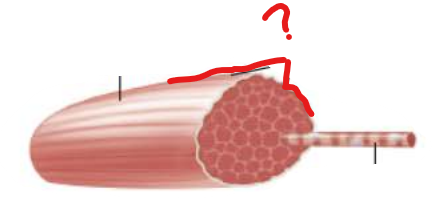
name this
what tissue is it made of?
perimysium
dense irregular connective tissue

name this
what type of filaments compose it?
i-band
thin filaments
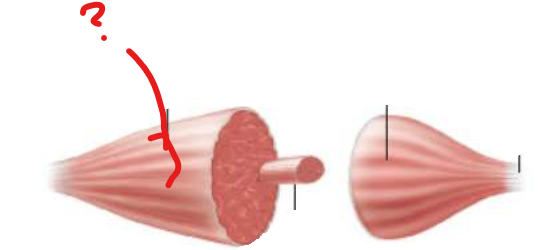
name this
what tissue is it made out of?
epimysium
dense irregular connective tissue
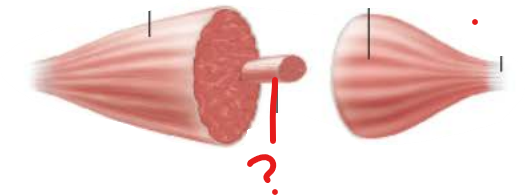
name this
what is its function?
fascicle
groups the muscle fibers
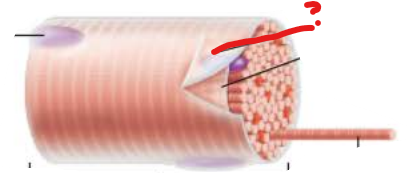
name this
describe it
endomysium
wispy sheet of connective tissue that surrounds each individual muscle fiber
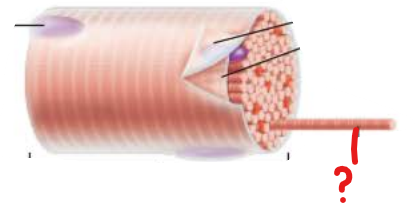
name this
describe it
myofibril
rodlike contractile elements composed of sarcomeres end to end
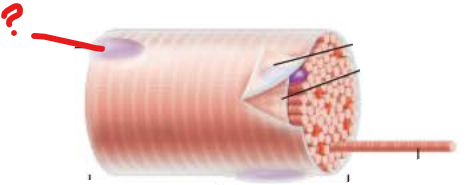
what is this?
skeletal muscle fiber nucleus
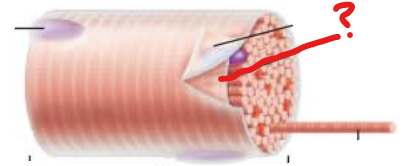
what is this?
sarcolemma
plasma membrane of muscle fiber
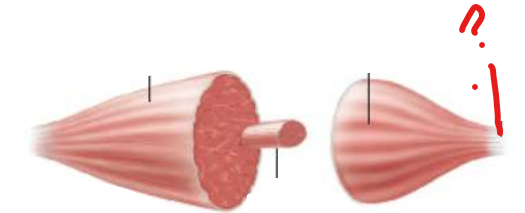
what is this?
muscle tendon

what is this entire structure?
what is it composed of?
myofibril
myofilaments

what is this?
where is it located?
what is it in regards to the skeletal muscle?
what is it made of?
sarcomere
region of a myofibril between two successive Z discs
contractile unit
composed of myofilaments made of contractile proteins
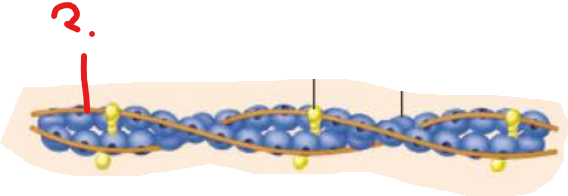
what is this
what is its function?
tropomyosin
blocks myosin binding site
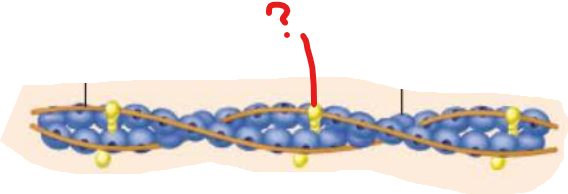
what is this?
what 2 things does it bind to?
troponin
binds tropomyosin to actin
binds to calcium ions
what are the four characteristics of muscle tissue?
excitability, receive and respond to stimuli
contractility, shorten forcibly
extensibility, stretch
elasticity, recoil after stretching
what are the four functions of muscle tissue?
produce movement
maintain posture and body position
stabilize joints
generate heat
describe the blood supply of skeletal muscle
what serves each muscle?
Rich due to large ATP demand
one nerve, one artery, and one or more veins
name two functions of the many sheathes of the muscle
contraction pulls on sheathes transmitting the pulling force to the bone
provides routes for blood vessels and nerve fibers
When a muscle contracts, the movable bone, the muscle's _______, moves toward the immovable or less movable bone, the rnuscle's _______. In the muscles of the limbs, the origin typically lies ________ to the insertion.
insertion
origin
proximal
what is a direct attachment?
epimysium of the muscle is fused directly to the periosteum of the bone or the perichondrium of the cartilage
what are indirect attachments?
tendons
aponeurosis
what causes the muscle to contract?
the sliding of the thin filaments over the thick filaments
what is sarcoplasm
-------------------------
just know that this is in there!
glycosomes
myoglobin
mitochondria
calcium ions
myofibrils
sarcoplasmic reticulum
t-tubules
cytoplasm equivalent for muscle fiber
what are the specialized structures of the muscle fiber?
myofibrils
sarcoplasmic reticulum
T-tubules
what are myofibrils? are they the contractile unit?
made up of sarcomeres chained together
no
The __________ is composed of the giant protein _____. It holds the ___________ in place, maintaining the organization of the_______ , and helps the _______ cell spring back into shape after __________.
elastic filament
titin
thick filaments
A band
muscle
stretching
sarcoplasmic reticulum
resembles smooth ER
regulates intracellular levels of ionic calcium
stores calcium in terminal cisterns and releases when muscle is ready for contraction
The ______ (cavity) of the ________ is continuous with the _____________. This increases the __________ surface area. This allows changes in the membrane potential to rapidly penetrate deep into the muscle fiber.
lumen
T-tubule
extracellular space
muscle fiber's
what are triads?
successive grouping of the three membranous structures
terminal cistern
T-tubule
terminal cistern
describe a contraction in terms of insertion and origin
insertion moving towards origin
what is the sliding filament model of contraction?
during contraction thin filaments slide past thick ones so that actin and myosin filaments overlap to greater degree
what is excitation-contraction coupling?
muscle fiber stimulated by nerve
propagated action potential
intracellular calcium rises
calcium triggers contraction
what forms the neuromuscular junction?
motor nerve terminal
synaptic cleft
motor end plate
what is the synaptic cleft?
space between motor end plate and motor nerve terminal
what are synaptic vesicles?
sacs of acetylcholine in the axon terminal
what is the motor end plate?
trough in sarcolemma at neuromuscular junction with ACh receptors
what is muscle tension?
force exerted by contracting muscle on an object
what is load?
opposing force exerted on muscle by the weight of the object to be moved
what is an isometric contraction?
describe the muscle length during this
what is the function of this type of contraction?
contracting muscle develops tension but load is not moved
muscle length is not changed
maintains posture and holds joints stable
what is an isotonic contraction?
what are they two types?
contracting muscle develops enough tension to move load
concentric contraction
eccentric contraction
muscle generates force as it shortens in ___________________
muscle generates force as it lengthens in __________________
concentric contraction
eccentric contraction
what is a graded muscle response?
what are the 4 types?
contractions differ in strength depending on what the motor unit is trying to accomplish
what two factors impact the strength of contraction?
frequency of stimulation
strength of the stimuli
what is wave summation?
2 nerve impulses delivered in rapid succession
second contraction occurs before muscle is relaxed from first contraction making the second twitch stronger than first
what is the Treppe: Staircase effect?
muscles contraction is weaker after a long period of rest
muscle contraction after each repeated successive stimulus is stronger during initial muscle activity
what is muscle twitch?
response of a motor unit to a single action potential
what is a myogram?
graphic recording of contractile activity
what is the latent period?
after stimulus tension builds but no response on myogram
what is the period of contraction?
when cross bridges are active
what is the period of relaxation?
what is it initiated by?
muscle tension at zero
initiated by reentry of calcium into SR
what is muscle tone?
does it produce movement?
what is its function?
muscles being always slightly contracted through reflexes
does not produce movement
stabilizes joints and keeps muscles ready to respond to stimuli
what is aerobic respiration?
what three things does it produce?
oxygen is consumed and glucose is broken down entirely
produces water, co2, and ATP
what is anaerobic glycolysis?
does it use oxygen?
how much glucose does it use?
how much ATP does it produce?
what is the effect of the product it produces?
energy production by conversion of glucose to lactic acid
does not use oxygen
requires large amounts of glucose
only makes 5% of the atp compared to AR
-actic acid accumulation causes muscle fatigue and soreness
what are the three types of muscle fibers?
slow oxidative fibers
fast oxidative fibers
fast glycolytic fibers
what is the difference between slow and fast fibers?
speed of contraction
reflects how fast ATP is made
oxidative fibers use an __________
glycolytic fibers use an __________
aerobic path
anaerobic path
why do muscles contain a mixture of fiber types?
allows a range of contractile speeds
fatigue resistance
what are the effects of aerobic exercise on muscles?
increased capillaries surrounding fibers
increased mitochondria count
increase in myoglobin
increased endurance, strength, and fatigue resistance
what are the effects of resistance exercise on muscles?
increased muscle hypertrophy
increased muscle fiber size
increased mitochondria count
increased glycogen stores
why are smooth muscle cells organized in sheets where 2 sheets are in right angles in organs?
allows for peristalsis
compare the sarcoplasmic reticulum in smooth muscle vs skeletal muscle
no t-tubules in smooth muscle
no terminal cisternae in smooth muscle
relies more on extracellular calcium from calveoli
what does smooth muscle contraction have instead of synaptic vesicles?
instead of a neuromuscular junction?
does it release ACh?
varicosities
diffuse junction
yes, but also other neurotransmitters
do all stimuli initiate an action potential in smooth muscle?
no some responses are local
what is the stress-relaxation response?
stretch
contraction
propel substances through hollow organs
relax
what stretches more smooth muscle or skeletal muscle?
smooth muscle
what dictates the muscle fiber recruitment process?
what type of motor units are activated first?
why?
what purpose does this serve?
size principle
the motor units with the smallest muscle fibers are activated first
because they are controlled by the smallest most highly excitable motor neurons
allows for the increase in force during weak contractions
describe skeletal muscle tissue in its structure:
# of nucleus
shape
striations?
---------
describe its contractility
multinucleated
cylinder shape
striated
rapid
describe smooth muscle tissue
# of nucleus
shape
striations?
-----------
describe its contractility
uninucleated
spindle-shaped
no striations
describe cardiac tissue
# of nucleus
shape
striations?
----------
describe its contractility
uni or binucleate
branches
striations